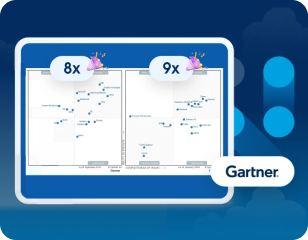Benefits of a microservices and monolithic architecture
Tech giants such as Netflix, Google, and Amazon are turning to microservice architectures over monolithic architecture. But why? There are clear difference between microservices vs monolithic architectures, but what are the advantages and disadvantages of each?
How microservices and monolithic architectures impact technical debt
The business benefits of a microservices vs a monolithic architecture are significant. When deployed properly, a microservices based architecture can bring significant value to the business. That value can be expressed in both technical debt being avoided and a substantial increase in efficiency.
For example, technical debt from a monolithic code base is a measurable reality in traditional DevOps. With monolithic code, even segregated components share the same memory, as well as sharing access to the program itself. While that may make it a little easier to code interfaces and implement applications, it ultimately takes away the flexibility that should be a part of the agile development process.
What’s more, a monolithic code base introduces an exponential level of inefficiency that increases technical debt. For example, chores such as bug resolution, interface modifications, adding capabilities, and other changes to applications, impacts the application as a whole, introducing downtime, as well as creating an environment where inefficiencies can unintentionally be introduced. Simply put, monolithic code bases are more time consuming to work with, are less adaptable and ultimately, more expensive to maintain, which in turn increase technical debt.
A microservices-based architecture eschews many of monolithic architecture’s problems that can create technical debt, and in turn, brings measurable cost savings in both time and speed to market.
How microservices and monolithic architectures impact agility, efficiency, and more
Reducing technical debt is an important benefit offered by microservices; however, measurable savings do not end with just technical debt. Microservices offer other benefits to the business which can reduce costs and impact the bottom line. Those benefits include:
- Agility: By breaking down functionality to the most basic level and then abstracting the related services, DevOps can focus on only updating the relevant pieces of an application. This removes the painful process of integration normally associated with monolithic applications. Microservices speed development, turning it into a process that can be accomplished in weeks and not months.
- Efficiency: Leveraging a microservices based architecture can result in a far more efficient use of code and underlying infrastructure. It is not uncommon to experience significant cost savings by as much as 50% by reducing the amount of infrastructure required to run a given application.
- Resiliency: By dispersing functionality across multiple services eliminates an application’s susceptibility to a single point of failure. Resulting in applications which can perform better, experience less downtime and can scale on demand.
- Revenue: Faster iterations and decreased downtime can increase revenue (either using efficiencies created via a chargeback ideology or by improving user engagement). User retention and engagement increases with continuous improvements offered by microservices.
Organizations looking to maximize productivity, embrace agility and improve customer experience should look beyond yesterday’s monolithic Web applications and embrace microservices, whose loosely-coupled architectures speed development, testing, and deployment, accommodating today’s and tomorrow’s digital requirements.
Best practices for building microservices architectures
Interested in learning more? Take a look at more resources on best practices for implementing microservices in your organization.



